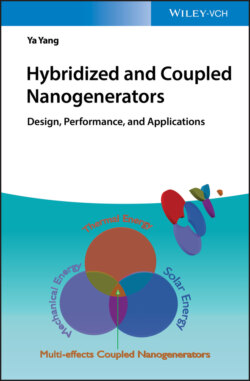Читать книгу Hybridized and Coupled Nanogenerators - Ya Yang - Страница 28
2.3.1.2 Enhanced Plate‐Based TEGs
ОглавлениеThe device structures and materials can affect the output performance of triboelectric generators (TEGs). To increase the actual efficiency for harvesting wind energy, some improved structures have been invented by optimizing the structures of the devices. For example, Yang's group proposed enhanced plate‐based TEG, which consists of two polytetrafluoroethylene (PTFE) films, two Al foils, and a Kapton film coated with Al electrodes on its surfaces (Figure 2.4a) [33]. To bring wind‐induced vibration, one side of the Kapton film was fixed. The side view of the fabricated plate‐based TEG shows that the device is small, with the dimensions of 22 mm × 10 mm × 57 mm (Figure 2.4b). Figure 2.4c shows the front view of the device, with a thickness of about 2 mm.
Figure 2.3 Sketches illustrating the electricity generation process (a–f) in plate‐based TENG.
Source: Reproduced with permission from Yang et al. [32]. Copyright 2013, American Chemical Society.
Figure 2.4 Diagram of the enhanced plate‐based TEG. (a) Schematic diagram of the TENG. (b,c) The side and front views of the TEG. (d) Sketches illustrating the electricity generation process in enhanced plate‐based TENG.
Source: Reproduced with permission from Wang et al. [33]. Copyright 2015, John Wiley and Sons.
The working mechanism of the enhanced plate‐based TEG is schematically depicted in Figure 2.4d. At the initial state, both TEG‐1 and TEG‐2 are in the static condition, resulting in no output signals (Figure 2.4d(1)). When the Al electrode contacts with the top PTFE film in the TEG‐1, electrons will be transferred due to different triboelectric series, and their surfaces will respectively form positive charges and negative charges. This process will generate a balance due to the nature of the insulator, leading to no output signals (Figure 2.4d(2)). When the distance between the Al electrode and the Kapton film was increased under the external force, the balance was broken, which could generate the current signal through an external load in the TEG‐1, as shown in Figure 2.4d(3). The electrostatic induced charges disappeared when a new balance is built, as descripted in Figure 2.4d(4). In this state, the surface of the Al electrode forms positive triboelectric charges, and the surface of the bottom PTFE film forms negative charges in TEG‐2. Increasing the distance between the Al electrode and the bottom PTFE can induce two output signals in TEG‐1 and TEG‐2 due to electrostatic induction.
